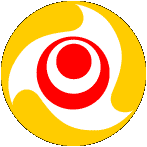Uechi Ryu Karate Do
| In 1897, a young man named Kanbun Uechi left his homeland of Okinawa for Mainland China in order to flee the Japanese military and to study Chinese martial arts and medicine. He was 19 years old. In the Fukien province of China, Uechi studied Kempo with Shusshabu and Shushiwa, monks of the Shaolin temple. The system he learned, Pan gai noon (half-hard/half-soft), was based on the fighting styles of the Tiger, Dragon, and Crane. After 10 years of study, he opened his own school in the Nanching province. He left for his homeland of Okinawa after 2 years, vowing never to practice or teach martial arts again, after a student of his killed a neighbor in a dispute over irrigation. In Okinawa, he married and lived peacefully until a former student of his visiting from China, Mr. Gokenkien, the tea merchant, defeated several local karateka in combat. This newcomer declined numerous invitations to teach, saying that his teacher was much better and lived nearby. When questioned, Kanbun Uechi denied all knowledge of the martial arts, but was tricked into performing Seisan kata to protect his honor at a demonstration given by the Motobu police.Kanbun Uechi then left for Japan to find employment. He settled in Wakayama City in the Kansai region near Osaka. There, his young neighbor, Tomoyose Ryuyu, persuaded him to once again teach Pan gai noon. He did so by claiming to have been attacked and asking Uechi what he would have done. Eventually Kanbun began teaching once again. The teacher's new students so respected him that they renamed the system after him in 1948. |
 Kanei Uechi performing a Front Toe Kick |
|
Kanbun Uechi's son, Kanei Uechi, also contributed to the style. (The second son born to Kanbun and his wife was named Kansei.) To the original style (consisting of the kata Sanchin, Seisan, Sanseirui, arm-rubbing/arm pounding called kotikitae, and Chinese medicine), Kanei Uechi added five new kata (Kanshiwa, Kanshu, Seichin, Seirui, and Kanchin), the beginning exercises (called Hojo Undo), and various kumite forms, mainly yakusoku kumite (Kyu Kumite, Dan Kumite, and the bunkai for Kanshiwa and Seisan). Kanei died in February of 1991, leaving behind a strong growing system of Okinawan karate. Just prior to his death, the system began to splinter. His son, Kanmei, now heads the Soke or family organization, while many of the Senior instructors banded together to form the Okikukai Shohei Uechi Ryu organization. The Birth of Uechi-Ryu Karate Do |
The Okikukai Emblem
 The
emblem is really a composite of two symbols, one representing
the old Okinawa and one the new. The off-center
circle-within-a-circle is the official prefectural symbol of
Okinawa; the outer red ring represents the ocean, the inner
white ring peace, and the central red sphere means development
or progress. This symbol of modern Okinawa is enclosed
within a symbol of the ancient Ryukyuan Kingdome consisting of
three yellow waves that circle a white region. The Okinawan
emblem combines symbols to represent the continuity of ancient
Ryukyuan values within modern-day Okinawa, and the concentric
circles motif symbolizes, variously, the eternity of Heaven and
Earth, self-completion, equality, and peace. This whirling
vision of justice and peace, so central to the Okikukai
philosophy, is also the confident expression of the belief that
the ancient Ryukyuan ethos continues and will continue to
enliven Okinawan life.
The
emblem is really a composite of two symbols, one representing
the old Okinawa and one the new. The off-center
circle-within-a-circle is the official prefectural symbol of
Okinawa; the outer red ring represents the ocean, the inner
white ring peace, and the central red sphere means development
or progress. This symbol of modern Okinawa is enclosed
within a symbol of the ancient Ryukyuan Kingdome consisting of
three yellow waves that circle a white region. The Okinawan
emblem combines symbols to represent the continuity of ancient
Ryukyuan values within modern-day Okinawa, and the concentric
circles motif symbolizes, variously, the eternity of Heaven and
Earth, self-completion, equality, and peace. This whirling
vision of justice and peace, so central to the Okikukai
philosophy, is also the confident expression of the belief that
the ancient Ryukyuan ethos continues and will continue to
enliven Okinawan life.

